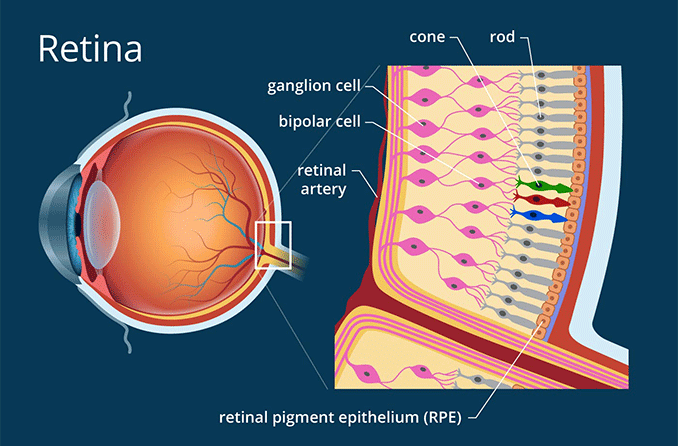Leber congenital amaurosis: Risk factors, causes, symptoms and diagnosis

What is Leber congenital amaurosis?
Leber congenital amaurosis (LCA) is a rare retinal dystrophy that causes vision impairment. Impairment is usually present at birth, but it may worsen over time, causing severe vision loss at an early age. Other common symptoms include light sensitivity, involuntary eye movement and extreme farsightedness.
LCA was first described in 1869 by Theodor Karl Gustav von Leber.
What causes Leber congenital amaurosis?
Leber congenital amaurosis is caused by a genetic mutation that is present at birth (congenital). This mutation impairs the development and function of the retina, resulting in vision loss early in development.

You have millions of color-sensitive cone cells in the back of each eye.
Rods and cones are photoreceptors in the retina — cells in the eye that convert light into images. Rods are better at seeing black and white, enhancing night vision. And cones are better at absorbing color. LCA affects the function of the rods and cones.
For more information about how vision works, read Vision: How does eyesight work?
Genetic disorders
Infants receive two sets of genes, one from each parent. These genes contain blueprints for building and maintaining the body. Individuals typically have between 20,000 and 25,000 genes.
There are two kinds of genes: dominant and recessive. Dominant genes are those that only require one copy to show up in an individual. Recessive genes require two copies to appear.
Those who have one dominant and one recessive gene for a trait are called “carriers.” This is because, while they will not show signs of the recessive trait, they can pass that trait on to offspring.
Genetic testing can help you determine the risk of passing an affected gene to your offspring.
Leber congenital amaurosis is one of the most common causes of childhood blindness.
SEE RELATED: Marfan Syndrome and the Eyes and Best Disease
Genetics and Leber congenital amaurosis
Leber congenital amaurosis is caused by a mutation in a single gene (monogenic). There are 27 genes that have been connected to LCA. However, these only account for 80%-90% of cases. The genes responsible for the other 10%-20% of cases are currently unknown.
Because the mutation that causes LCA is present when the baby is born, it is considered a congenital disorder.
The genetic mutation that causes LCA is recessive. This means that an infant must inherit a copy of the mutated gene from each parent in order to develop the condition. If each parent carries the recessive gene, there is a 25% chance of the child inheriting both mutated genes.
There is no observed link between LCA and a particular sex. LCA appears in two to three out of every 100,000 newborns, making it one of the most common causes of childhood blindness.
Congenital eye disorders
Congenital eye diseases cause issues with vision development while a baby matures during pregnancy. Some, like LCA, are caused by a genetic mutation. Others can be caused by drug or alcohol exposure in the womb. And some have no known cause.
These disorders can affect any segment of vision development, and symptoms vary. Glaucoma and cataracts are common congenital eye disorders.
What are the symptoms of Leber congenital amaurosis?
Vision impairment is the main symptom of Leber congenital amaurosis. However, there are several associated symptoms of LCA.
These can include:
Franceschetti’s oculo-digital sign – regular pressing/poking of the eye
Keratoconus – a cone-shaped cornea
Nystagmus – involuntary eye movements
Hyperopia – extreme farsightedness
Cataracts – a clouding of the lens
Photophobia – unusual sensitivity to light
Strabismus – crossed eyes
Intellectual disability, hearing loss and olfactory impairment — reduction or loss of smell — are rare but may also be present.
Leber hereditary optic neuropathy
Leber hereditary optic neuropathy (LHON) is another genetic form of vision impairment. Unlike LCA, symptoms do not typically appear until the individual is in their teens and 20s. Vision impairment is usually the only symptom of this disorder. LHON typically affects young males.
How is Leber congenital amaurosis diagnosed?
Parents may notice some of the major symptoms early in their infant’s life. Wandering eye movements and a reduced response to visual stimuli are common. Parents may also notice the child repeatedly rubbing or poking their eyes.
If a healthcare provider suspects LCA, they may use electrodiagnostic testing (electroretinography) to evaluate visual function. This test measures the retina’s function. An infant with LCA will show reduction of and limits to the function of the retina.
The doctor may then conduct a molecular genetic test. This test will look for mutations among the specific genes that cause Leber congenital amaurosis.
What is the treatment for Leber congenital amaurosis?
The main treatment available for Leber congenital amaurosis is gene therapy. In 2017, the U.S. Food and Drug Administration approved Luxturna.
This gene therapy, manufactured by Spark Therapeutics, Inc., can be used for children and adults. It treats mutations in the RPE65 gene. This gene is what teaches the body to produce a protein that is necessary for normal vision.
The goal of gene therapy is to create sustained improvements in sight and create more independence for the affected individual. Gene therapy does not cure blindness.
Gene therapy
Gene therapy is a treatment method that focuses on altering a patient’s genetic makeup instead of using medication or surgery. Through the methods of gene transfer and genome editing, physicians are able to:
Input a new gene to help the body fight a specific disease.
Input a healthy gene to replace one that is mutated.
Repair an altered gene.
Activate a gene to help the body fight a disease.
Shut down an impaired gene.
Erase a piece of DNA that is interfering with healthy gene function.
When should you seek assistance?
If your child repeatedly pokes or rubs at their eyes, this could be a warning sign of Leber congenital amaurosis. Other signs include wandering eyes that don’t appear to focus on anything, eyes that are sunken in and cloudy pupils. All of these are indicators that it is time for the child to see an eye doctor.
It is important for babies to receive a comprehensive vision examination in the first six months of life. They should continue to receive regular eye exams throughout childhood. These measures can help diagnose conditions such as Leber congenital amaurosis early on and allow for appropriate care.
For more information about eye check-ups for children, read Eye exams for children: Why they're important.
Leber congenital amaurosis. National Organization for Rare Diseases. 2020.
Leber congenital amaurosis. EyeWiki. American Academy of Ophthalmology. November 2020.
Leber congenital amaurosis. MedLine Plus. August 2010.
Leber congenital amaurosis (LCA). Foundation Fighting Blindness. Accessed July 2022.
What is a gene? MedLine Plus. March 2021.
What are dominant and recessive? Learn. Genetics. University of Utah. March 2016.
Human olfactory dysfunction: causes and consequences. Cells and Tissue Research. January 2021.
Stereotypic movement disorder. MedLine Plus. March 2020.
Photoreceptors. Kenhub. June 2022.
What is a congenital disorder? Pregnancy, Birth and Baby. June 2021.
RPE65 gene. MedLine Plus. August 2010.
What is gene therapy? MedLine Plus. February 2022.
Congenital eye diseases. Ann & Robert H. Lurie Children’s Hospital of Chicago. 2022.
Vision screenings for babies & children. American Academy of Pediatrics. March 2022.
Page published on Wednesday, August 3, 2022
Medically reviewed on Friday, July 29, 2022






